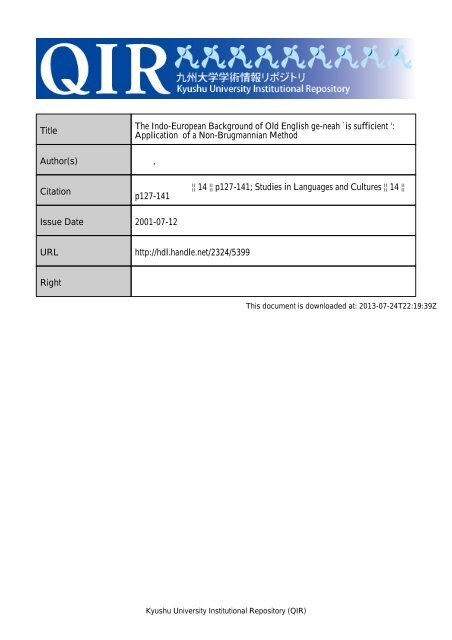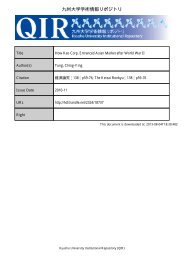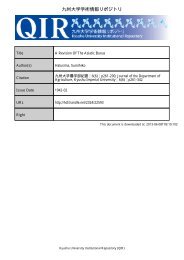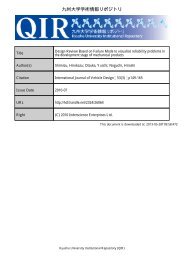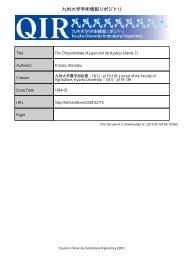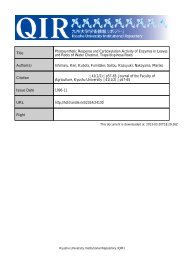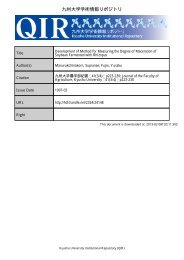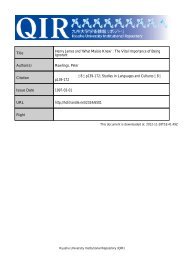Create successful ePaper yourself
Turn your PDF publications into a flip-book with our unique Google optimized e-Paper software.
a. gntredasctigme<br />
Tke gndg-Eur*pean Backgronmpd<br />
of Ogdi EmagRisla ge-esemb `fis stwifgcfient':<br />
Studies in Languages and Cultures, No.14<br />
Appggcagggme of a Ngee-Brugtwftpmmefiapm Metked<br />
Tgshiya Tamaka<br />
Grounded upoR the hypothesis that the PIE verbal system was of an active-inactive type,<br />
propounded by Gamkrelidze and Ivanov (1984/1995), Lehmann (1992, 1993), KurzovA<br />
(i993), among others, Tanaka (2eelb: 53ff.) proposes a method for extrapolating the originai<br />
PIE morpho-semantic category of a given IE verb. It is comprised of the followiag four<br />
cxxtena:<br />
(1)<br />
I. a. If the meaning reconstructible for a giveR IE verb is agentive, it is likely to suggest<br />
that the verb at issue desceRded frrom an original active verb.<br />
b. If a non-agentive meaning is reconstructible for a given IE verb, it is likely to<br />
suggest that the verb at issue derived from an ortginal inactive verb.<br />
N.B. Since agentivity, as well as Aktionsart, of a reconstructed meaning is ofteA<br />
ambiguous, this criterion should not be used exclusively.<br />
II. a. If a given IE verb has an etymological counterpart which suggests itself as a (direct)<br />
refiex of the Mi CeC-m(i)/s(i]/t(i) configuratioit, it may point te an original active verb.<br />
b. If the pertinent verb lacks it (but shows a reflex of the XiCe/oC-h2e/th2e/e<br />
configuration), it may point to an original inactive verb.<br />
N.B. An ostensibly archaic verbal morphology caR be an analogical creatien, especially<br />
when the morphelogy at issue is productive in the pertinent IE dialect, and therefore,<br />
this criterion alene is not to be heavily relied upoR.<br />
III. a. Ifa given IE verb has a very archaic agent noun X:CeC-te"/tipt, it can hint at an originai<br />
active verb.<br />
b. If the relevant verb lacks it, on the other hand, it can hint at aR origima1 inactive verb.<br />
N.B. A seemingly archaic agent noun can be a secondary creation, especiaily when the<br />
nominal formatioR at issue is productive in the pertiRent IE dialect, and therefore,<br />
this criterion alone is not to produce coRclusive evidence for the origima1 category.<br />
IV. a. If a Hittite verb corresponding to a given IE verb shows a mi--conjugatien (save for<br />
nasal-infixing, X:yo-suffixing, "isk-suffixing, etc., mi-conjugations), it might perhaps be<br />
suggestive of an original active verb.<br />
127
2 'X'`E-]i2:tIzrktrt)tirrl4<br />
b. If a Hittite verb corresponding to a given IE verb shows a bi-conjugatioR, it might<br />
perhaps be suggestive of an inactive verb.<br />
N.B. Because many }{ittite verbs seem to have undergene replacement of the original<br />
conjugatioit cl3ss by the other ene, this criterioit must be regarded as a weaker ene.<br />
This paper attexnpts to give a new accouRt of the pre-histery of the eE CIass V preterite-<br />
preseRt ge-neah `is sufficient' aRd its Germanic couRterparts by applying this method to<br />
analysis of related IE lexemes.i) The problem of what PIE verbal class OE ge-neah may<br />
reflect is approached below.2)<br />
2. PffE Sckweheak#awt<br />
The PIE base underlying OE ge-neah er Grr}c. *'nah- `be sudicient' may be considered to<br />
be *'ffneE-. Since BeRveRiste's (1935: X52) propesal, the Schwebeablaut between wt'ffon-E-<br />
(Type I) and *iffn--ek- (Type II) has nermally been accepted by scholars (pace Antti!a i969:<br />
a24ff.).3)<br />
First, a variety of morpholggies of IE verbs related to OE ge--neah `is sufficient' must be<br />
ebserved. The fellowing chan coilects tegether pertinent materials frem xnajor IE dialects<br />
(cÅí WaXde and Pokemy 1930-32: I. 128f.; Pokomy a994: g. 316ff.; Seebold X970: 355f.;<br />
Lehm3nit X986: 70f.; Kromasser 1966-87: I. 269, 437; P"hvea X99X: 289-292; WhitRey 1885:<br />
1, 4, 87, 89; Macdenell 19a6: 369, 394, 395; amoRg others):<br />
(2) Verbs from PIE "iffen-E- er xiffn-eE-<br />
a. OInd.<br />
i) V aS, amS<br />
pres. (V, Ved.) as'-no-ti `1}e attains'(< *'ffzlEmees-ti)<br />
petf. (Ved.) ana'm. s'a, anaga `he h3s attained'<br />
aer. (eitly in the Atmanepada or middle) asta `he attaiRed himseif'<br />
l) Here I omit an exposition of the reconstructed PIE active-inactive verbal system upon which I am basing<br />
my analysis below. For this, see Tanaka (2001b: S2.2; fortheoming: g3.2; etc.).<br />
2) Tanaka (2eOO: 299f.) has already briefiy discussed this problem oniy in the light of the third criterion in<br />
(X) above, leaving aside a detailed morphological analysis of related IE lexemes. This paper aims at a<br />
more comprehensive histerical and comparative examination of the OE preterite-present verb concerned.<br />
3) The value ef the iRitial laryngeal seems to be controversial. Benveniste (1935: l52), Beekes (1969:<br />
236), Puhvel (1991: 292), Sihler (1995: 485), etc. postulate it as X:ki, and Mayrhofer (1986: l34), etc.<br />
as "h2. See Lindeman (!987: 77f.) and the references cited there for this issue. Despite this difficulty,<br />
however, it seems that the description adopted here, based on Benveniste's root theery, better captures<br />
the nature of the base alternation than the traditional description where the bases "enek-, "nek-, *•enk-<br />
are mereiy enumerated (cf. Pokorny l994: 316ff.; Lehmann 1986: 7i; etc.). Thus, this paper espouses<br />
the representation based on Schwebeablaut. Stronger evidence for the existence of the initial laryngeal is<br />
obtained not only by Hittite ijenk-zi `he lifts' (refiecting the PIE Type I base X:"enE-) but also by<br />
Old Indic inak-s-a-ti `endeavours to reach' (refiecting the PIE Type II base *ffenE-; cf. Beekes 1969:<br />
236). See also Cowgill (1965: 151), where other materiais suggesting the existence of the initial<br />
laryngeal are raised.<br />
128
TheIRdo-EuropeanBackgroundofOldEnglishge-neah`issufficient':ApplicationofaNon-BrugrnannianMethod 3<br />
N.B. Ne ageRt noun such as *"ia(2?z)s'-t.r `one whe attains' is attested (see Whitney<br />
1885: 4; Monier--WiNiams l899: ll4).<br />
iD Vaks<br />
pres. (I, RigVeda) ak-s-a-t `he attains' (< xiffgeE-s-e-t)<br />
perf Kndocumented (except for the petf. mid. ppi. diks-digea' `having attaiited oneself'<br />
in RigVeda; see Whitney 1885: 1; Monier-WMiarr}s 1899: 3; etc.)<br />
aer. 3 pl. des-is.-as `they attained' in RigVeda (see WhitRey 1885: 1; cf. Macdonela<br />
191e: p. 384, Note 7 and the references cited there).<br />
N.B. No agent Roun such as Xi'Xiaks-t.r `one who attains' is attested (see WhitRey i885:<br />
1; Menier-Williams 1899: 4; etc.).<br />
iii) Vitag, napeg<br />
pres. (I, Ved.) na's'-a-ti `he attains' (< "ffneE-e-ti)<br />
perf undocumented<br />
aor. (Ved.) a-nag `you/he att3ined'<br />
(Ved.) nat `he att3ined'<br />
N.B. No agent Roun such as "X: nas'-t.r `one who attains' is attested (see WkitRey 1885:<br />
89; Monier-Williams 1899: 532).<br />
iv) Vnaks<br />
pres. (I, Ved.) ntik-s-a-ti `he attains' (< 'i`ffneE-s-e-ti)<br />
perf. (Ved.) 3 pl. na-naks-dir `they have attaiRed',<br />
(Ved.) 3 sg. middle na-naks-e' `he has attained himseaf'<br />
aor. undocumented<br />
N.B. No agent moun sgch as ":"i'ndes-ig `one who attaiRs' is attested (see Whitney<br />
b. Av.<br />
i)<br />
2885: 87; Monier-Williams i899: 524).<br />
pres. asV-naoi-ti `he attains' (< '`ffgeE-neee-ti) (see Reichek 19g9: le4 and 4e3 s.v.<br />
gs-; Keileits 1984: 17e; among ethers)<br />
petf. undocumented<br />
aor. undocumented<br />
N.B. No agent Roun such as Xi" asV-tar- `one whe attains' is attested.<br />
ii)<br />
pres. nas-ai-ti `he attains' (< "iffneE-e-ti)<br />
perf undocumented<br />
aor. ondixs"ta `he attained', s-aor. (see Reichelt l9e9: 121; ameng ethers)<br />
N.B. No ageRt noun such as Xi'i`nas-tar- `oite who attains' is attested.<br />
129
4 rt. .im sc4t KrA. P)flac14<br />
c. Gk.<br />
pres. undocumented (suppletion by ÅëCpto `I carry')<br />
perf. gvlporca `I have carried'<br />
aer. ijyEyKoy `I carried'<br />
inf. evEvK(ly `to carry' (so far supposed to redect<br />
d. Lat.<br />
pres. nanciscor (OLat. nancio-) I attain<br />
perf na(n)ctus sum `I (have) attained'<br />
e. Hittite<br />
pres. ni-ni-kzi `he lifts' (-nin- beiRg an infix in the<br />
pret. ni-ni-kta `he lifted'<br />
pres. benhei `he allocates'<br />
pret. ijenkta `he allocated'<br />
Åí Lith.<br />
pres. nesVblS `I carry'<br />
aor. nesViaa `I carried'<br />
inf. n2sVtz to carry - -4 e<br />
g. OCS (cf. Schmalstieg 1976: le9ff; among others)<br />
pres. nes-g I (- amve, } reach<br />
aor. nes-ox-E `I canied'<br />
mÅí nes-tz to amve, reach - -{ - !<br />
h. OIr.<br />
pres. ro--icc `he reaches' (cÅí icc- < inc- < Xi`ink- <<br />
pret./perf. ro-dnaic (< X:On-onk-e)<br />
i• Arme<br />
pres. hasanem t- I arrive, p reach<br />
pret. hasz I arnve, reached -t- s<br />
j. Toch.<br />
A e7?zts- `carry, hold, seize'<br />
B ewhk- `carry, hold, seize'<br />
130<br />
either<br />
xi en-en k-<br />
stem ninink-),<br />
t-:• enknv)<br />
or '""ne-nk-)
TheInde-EuropeanBackgroundofOldEnglishge-neah`issufficient':ApplicationofaNon-BrugmanniaRMethod 5<br />
k. Gmc.<br />
pres.sg.pres.pl. pret. p.p.<br />
i --1<br />
Go. ga-nah - besufficient<br />
bi-nah - bi-nadehts `bepermitted,allowed'<br />
OE ge-neahge-nugon ge-nohte ; --p - besufficient<br />
c --p<br />
eHGgi-nah - - besufficient<br />
(3) belew, on the other hand, simply distingiiishes verbs reflecting the Type I base \'ffenE-<br />
from these refiecting the Type II Xi"nek-:<br />
(3) Type ll Typel<br />
ti Hnefe- Xi ffenk-<br />
Gk. gy-E7•ffc--EZv ( : inf. of gbef)co)<br />
Ved. na's'ati<br />
cf. Att. aor. 1 sg. ijv-E7K-a<br />
(< perf. with Att. redupl.)<br />
elr. ro-icc<br />
(< the lengthened grade "enk-)<br />
Av. nasaiti<br />
Hit ni-nin-k- Hit. henk--<br />
Lith. nes"uN (< ':`nesVo-)<br />
OCS. nesYttN (< 'i`nes"o-)<br />
Ann. hasi (aor.)<br />
hasanem (pres.)<br />
Gmc. '":nah-<br />
nasalinfix. Ved.agn6ti<br />
Av. as"naoiti<br />
(< x:ffgek-neza-)<br />
Latin nanciscor (deponent)<br />
(perf. na(n)ctus sum)<br />
Toch. A e??Tts-, B erk-<br />
Since Gmc. "inah- `be sufficient' is interpretable as refiective of the (Type ID base Xi"neE-,<br />
the primary concern of this paper converges on analysing those IE verbal forms stemming<br />
frem this base.<br />
3. AppgicatioR of the Methed Concemaed<br />
Among the verbs refiecting the Type II"iffnek- in (3) above, there are enes which show<br />
obviously innovative or non-archaic ferms (cÅí the second term in (1) above). OInd.(Ved.)<br />
i3i
6 -- r-Y it Tk 'fifui 14<br />
ndsati, Av. nasaiti `he gains, attains', Lith. nes"uS, OCS nesg `I carry', Ann. hasanem `I<br />
come to, arrive' show thematic present forms; OInd.(Ved.) a's'no'ti and Av. asVnaoiti (<<br />
"i ge2-nees-ti) `he gains, attains' point to masal infixation; Latin scanciscor `I get, obtain' (cÅí<br />
perf na(n)ctbls sum), a depeneRt, is enlarged by the Xi -sk- element.4) A couple of 01d Indic<br />
(Vedic) materials, on the other haitd, suggest archaisms.5) The 2 sg. present nak-si `you<br />
gain, attain' appears to reflect an athematic preseitt X!sceE-si, from which Pokorny (1994:<br />
316) infers that the verb na's'ati origin31iy tegk alt athematic conjugatien for the preseRt.<br />
Moreever, the aorist thnat `he gained, attained' is frequemtly 3ssumed So be a root aorist,<br />
refiecting PIE Xie-ffneE-t. See Cowgill (i965: 151), Lindemait (a987: 78), Sihler (1995:<br />
485), araoitg ethers.<br />
If scak$i er tiscaS is not ait Oid Indic innovation and trtgly refiects ait archaic PIE verbal<br />
ferm, it wial suggest that the relevant base produced an active verb XiffneE-m(i)/s(i)/tav. But<br />
the Germanic Xinah-, uRiess it is ascribed to ait innovaticn iit Germanic, at the same tirr}e<br />
points to an archaic PIE verbai form, XiffnoE-h2e/th2e/e, the meaRing of which should be<br />
receRstructed as `be iR the state of reaching or attaining (tke ge3i, Roim, standard, etc.)'<br />
(> `be sufficient, eneugh').6) In my own theereticai ftarnework (cf. TaRaka 20Qlb: g2.2;<br />
forthcomiRg g3.2), it seems natural to decide that 3 PgE base produces either an active or an<br />
inactive verb, but not both. In ether words, the theory cencemed would require that either<br />
the eld Indic or the Germanic materials sheuld be aR innovatieft, though neither Oid Indic nor<br />
Germanic seems to provide very crticial, direct evidence for this.<br />
By means of the method spelt out in Z above, g should attempt to pass my judgement<br />
upon this dilemma. Despite the first term in (1) above, neither `(agentively) gain, 3ttain'<br />
4) Inside the verbal stem of Latin nanc-i-sc-or a nasal element is observable. To posit *Nne-n-k-, a Type II<br />
base with a "Position 2a" nasal infix (cf. Karstien 1971; Tanaka 20gla: 93.2), may be indepeRdently<br />
raotivated by the Ved. I sg. middle aorist ntimpSi, the 3 sg./pl. perfect ascdimpSa, anaSder, the elr. suthxless<br />
preterite stem -anec-, etc. (cÅí Lindeman X987: 77f.). But the a-vocalism in Latin nanc- still remains<br />
problematic, as Seebold (a970: 355) among others acknowledges.<br />
5) Hittite (ni)nihzi takes the mi-conjugation and has the meaning `lifts', which may be understood as of<br />
durative/imperfective Aktionsart. Despite the fourth term in (i) abeve, this material itself does not<br />
provide reXable morphological or semantic evidence in judging the original status of the verb. The Hittite<br />
mi-cenjugatlon, reguiariy accompanied by preterites without a thematic vowel and with endings frem<br />
IE "-m "-s, "'-t, etc., is considerably productive, and we can conjecture that a considerable number ef<br />
Hittite verbs showing this conjugation come from the original ip-conj'ttgation class (cf. Tanaka 2eelb:<br />
g3.3). The meaning `lift' seems ascribable to a secoRdary development in Hittite from the reconstructed<br />
meanmg which shottld be somehow related to the not!on gain , attam or reach .<br />
6) If this option is taken (belew we will actually do so), it will fo11ow that the Germanic preterite-present<br />
refiects the original state-denoting inactive verb from the reievant base. There is little or no reason to<br />
hold that the•preterite-present rk'nah- was analogically created inside Germanic. Since the category of<br />
`preterite-present' must have been in the process of being lost (the histery of English actually show this<br />
tendency; cÅí Visser 1963-73: III. ggl343, 1369ff. & 171Xff.; Wamer l993: l4i; Denlson l993: 296f.<br />
& 315f.; etc.), there should have been no motivation for the relevant verb to change the original<br />
morphology sk'ffnek-m/s/t to *Unok-he2e/th2e/e. Moreover, the rneamng suffice, be sufficient, enough<br />
is readily derivable from the supposed original meaning `be in the state of reaching, attaining (the goal,<br />
norm, standard, etc.)'.<br />
132
TheIndo-EuropeanBackgroundofOldEnglishge-neah`issufficient':ApplicationofaNon-BrugmannianMethod 7<br />
itor ` be in the state of attaininglreaching' seems uRsuitable for a reconstructed meaning<br />
of PIE xiffneE-,7) for what we cait say at this stage ef the argttment is that the reconstructed<br />
meaRmg should have somethiRg to do with the notion gain, attam and the agentivity or<br />
stativeness of the meaniRg is Rot to be directiy knewR. As regards the mophoiogical<br />
propenies, both Old Indic and Germanic materiais appear to show archaic characters, and the<br />
second criterion iR (1) alone does Rot seem capabie ef cleariRg up the current problem.<br />
Thus, the third criterioR is expected to p}ay its roge. As spelt out in the third clause iR<br />
(Z) above, it is worth while testing the case by means of the criterien of the existeRce<br />
er absence of an archaic agent neuR deriving from the reievant base.<br />
Materials from IE dialects do Rot previde any instaitce of an agent paun inheriting the<br />
form ":'x:ffneE-te/or `ene whe gains, attaiRs, reaches' (see (2) above agaiR). This provides a<br />
theoretical basis for the appraisai that an inactive verb rather than an active derived from PIE<br />
'y:' ffnek-. This wili, ift tum, suggest th3t the relevant Old Indic verba2 forms are mnevatioits<br />
whgch took piace at seme dialectal period.<br />
Giveit this iRterpretatioR, a mystery of Old Indic verbs refiecting "iffnek- will also, it<br />
seems to me, be illumimated iR a new fashion within our theoreticai framewerk. This is<br />
related with the question ef why there are more verbs than one for `attain, reach, anive at'<br />
in Old Indic, such as those reproduced below:<br />
(4) Vedic Verbs for `attain, reach, ttnive at' frem "iffenk- or XiLffnek-<br />
a. Rasal-infixing ag-no'-ti (< *ffgeE-neu-ti), see (2a) i) 3bove.<br />
b. s-eniarged dik-s-at (< XiffgeE--s-e-t), see (2a) ii) above.<br />
c. thematic ndg-a--ti (< 'kffneE-e-ti), see (2a) iiD above.<br />
d. s-enlarged na'k-s-ati (< X:LffneE-s-e-ti), see (23) iv) above.<br />
It is my opinion that this plurality ef related verbs points to their iRnovative character.<br />
If PIE had had ait active verb X: XiffneE-m/s/t `(voiuRtarily) gain, attain, reach', why is it<br />
not the case that Old IRdic shows only one verb directly refiective of this form, i.e., pres.<br />
na' s=a-ti vs. aor. *tz-nas-C > dnat; and why did eld Indic have te create Rew verbs by means<br />
ef nasai infix3tioR aRd stem-enlargexnent with ": -s-? k must be recaXled here that typicag PIE<br />
active verbs, such as *bher-mi/si/ti `bear, carry', "]ghwen-mi/si/ti `smite', X: deh3-m/s/t `give',<br />
Xidhehi-m/s/t `put, set' (see Tanaka 2000: g2 (l); 2eeab: g3.2 (5)), shew up in Old Indic,<br />
simply showing a pair of a present and ait aorist, without being accompanied by plurality of<br />
present aRd aorist forms:<br />
7) It seems natural to regard the meaniRg `gain, attain' as having the momentary/perfective, rather than<br />
durative/imperfective, Aktionsart. From this, it may be supposed that at least OInd. 2 sg. nak-si `you<br />
gain, attain' shottld be an intra-OInd. innovation; that is, the present at issue should have eiiginally<br />
been thematic, as exempiified by Vedic 1 sg. ndshmi and 3 sg. ndgati. It can, then, be inferred that at<br />
least there was no active-durative verb X: X!ffenk-mi/si/ti in the proto-language.<br />
133
8 S. Sg }Q[ {k rk ty7 v:u l4<br />
(5) Quondam Active Verbs in Old Indic<br />
a. PIE Xbher-mi/si/tz bear, carry , active-durative<br />
-; ts-<br />
OInd. pres. bi-bha'r-ti (Rigveda) vs. aor. bhar-tdm/bhgtta'm (Br2hmarpas)<br />
cf. pass. aor. a-bhar-i (Ved.)<br />
b. PIE *gWhen-mi/si/ti `smite', active-durative<br />
OInd. pres. ha'n-ti (Ved.) vs. aor. a-ii-ghan-at (Epic)<br />
c. PIE Xi'deh3-m/s/t `give', active-momentary<br />
OInd. pres. ddi-da-ti (Ved.) vs. aor. a'-da-t (Ved.)<br />
d. PIE Xidhehrm/s/t `put, set', active-momentary<br />
OInd. pres. dd-dha-ti (Ved.) vs. aer. a'-dhd-t (Ved.)<br />
CÅí Whitney (1885: l14, 202f., 71f., 82, respectively)<br />
This being the case, a pardcular explanation is required for the geResis of different shapes of<br />
a present and an aorist from PIE Xiffnek- or 'kffenk- in Old indic.<br />
Our theoretical appraisal that PIE had a state-denoting inactive verb Xiffnok-h2e/th2e/e<br />
`be in the state of attalning, reaching' but not an active-momentary verb X! *Hnek-m/s/t<br />
`attain, reach' seems to be capable ef giving a natural account of the Old Indic situation now<br />
in question. At some period between PIE and Old Indic (perhaps at Pre- or Proto-Inde-<br />
Iranian period), when the origiAal verbal category ef inactive was in the process of being<br />
lost,8) the relevant verb must have ceased to be a verb describing a non-agentive state and<br />
have been reinterpreted inte a verb for `(agentively) attain, reach, anive at'. At this period,<br />
a present (especiaily, a thematic present with an e-grade stem) must have started to be<br />
established as the basis of the verbal conjugation (cÅí Kurzeva 1993: l12f.). Several<br />
strategies must have been available to pre-literate Aryans to arrive at the reiRterpretation at<br />
issue.<br />
The enlargement of the stem by "i'-s- is especially noteworthy in traciRg this precess.<br />
The enlarged stem Xi-LffneE-s- is attested only in the Indo-Iranian branch (cf. Av. e'-naks"-;<br />
see Mann 1984-87: 834) and is obviously aR Indo-Iraniaft innovation. This "i-s- is<br />
interpretable as a perfectivising or punctualising element,9) aRd OInd. ndk-s-a-ti (Ved.) (<<br />
X:"nek-s--e-ti) and a'k-s-a-t (Rigveda) (< X:Hgek-s-e-t) are supposed to have beeR created<br />
from the original stative ":ffnok-h2e/th2e/e by modifying the o-grade stem into the e- er zero-<br />
grade, adding the 'k-s- element, and replacing the original endings with the thematic endings<br />
(i.e, xi-o-m(i), -e-s(i), -e-t(i)).iO) The change in vowel grade of the stem and the replacement<br />
8 ) This is because of the structura1 change from the active-inactive to the nominative-accusative type, which<br />
must have started in the Late PIE period (cf. Tanaka forthcoming: Note 8).<br />
9) For other instances where "-s-, an IE perfectivising or punctualising element, is used to enlarged the<br />
verbal stem, see Lehrman (1997: 154), Hewson & Bubenik (X997: 34), etc. For related discussion<br />
of this element, see Shields (1992: 35ff.), Lehmann (1993: l69 and 179f.), Kurzovg (1993: i81ff.), etc.<br />
10) It might perhaps be inferred that at a primitive stage of PIE there was a nominal verb "ffenk-e `(there is<br />
134
TheIndo-EttropeanBackgroundofOldEnglishge-neah`issufficient':ApplicationofaNon-BrugmannianMethod 9<br />
of the endings were obviously due to the reason that these were more suitable for a present<br />
in the new, present-based verbal system than the original o-grade stem and the original<br />
peculiar endings. What is important here is that the motivation for adding the perfectivising<br />
'"i'-s- to the stem becomes clear by the estimation that the original verb was inactive-stative.<br />
The original Aktionsart of the relevant verb was by no means momentary or perfective,<br />
but by adding the perfectivising "-s--, modification ef the AktioRsart into momentary or<br />
perfective (hence, the meaning `(agentively) attain, reach') was enabled. In other words,<br />
if we postulate that the original verb was active-perfective, there does not seem to be any<br />
motivation for adding the perfectivising element ":-s- to the relevant stem.<br />
Further evidence for the reinterpretation precess posited above seems to be obtained<br />
if we observe the distributienal pattem of a Gmc. preterite-present and cognate verbs in<br />
eld Indic. Examples of Xidars- (< ":dhors-) and 'nt:'barf- (< XitorP-), which are reasenably<br />
ascribable to previous inactve-statives,ii) are relevant here. (6) and (7) below demonstrate<br />
that it is occasionally the case that a Gmc. preterite-preseRt corresponds te seme innovative<br />
presents other than a simpie thematic present in eld Indic:<br />
(6)<br />
a. Gmc. "dars-(a)/t(a)/e `dare' (< "'dhors-h2e/th2e/e `be bold')<br />
b. OInd. dha'rs-a-ti (V2jasaneyi-Samhita, Rarnayarpa) `dares' (them.pres. < Xidhers-e-ti)<br />
(7)<br />
dh.rs.-uoili (from Vedas onwards) `dares' (nasal infix. < X:dh.rs-nees-ti)<br />
Cf. Whitney (1885: 85)<br />
a. Gnac. XiParf-(a)/t(a)/(e) `need' (< ":torP-h2e/th2e/e `be in the state of enjoying, be<br />
satisfied')<br />
b. OInd. `eftjoy, satisfy ofteself, be pleased'<br />
t.rmPdti (Vedas, Brahmarpas, Sutras), a thematic present with nasal infixation<br />
(< "t.rm-P--e-ti)<br />
t.ripsati (from Atharva-Veda onwards), a thematic present enlarged by "-y-<br />
(< x:tgp-y-e-ti)<br />
t.rPrpbli (Vedas, Brahmarpas), a nasal infixing preseRt (< *t.rP-nebl-ti)<br />
CÅí Whitney (1885: 65f.)<br />
a state/process of) attaiRiRg', which later differentiated into ts'HneE-h2e/th2e/e `be in the process of<br />
attaining' and *HnoE-h2e/th2e/e `be in the state of attaining'. No verb directly refiecting these survived<br />
into Old Indic. It is possible to hold that the reinterpretation now under discussien may have taken place<br />
oR the basis of the erstwhile inactive-processive verb (i.e., a medium tanatum, which would have showen<br />
up as xnag-e, Xinah-se, Xinas-.te, if it had survived into Old Indic). In this case, the reinterpretation<br />
process in creating nak-s-a-t is raore simply described, for it is involved only with attachment of X:-s-<br />
and raodification of the endings, witheut modification of the vowel grade of the stem (of course, assuming<br />
that this reinterpretation occured before the vowel change X:a, *'e, X:o > a took place).<br />
11) I will offer elsewhere a detailed explanation that these preterite-presents reflect PIE inactve-stative verbs,<br />
besides the concise suggestion advanced in Tanaka (2000: S3.3.1 and 93.3.2).<br />
l35
10 s-i•g';sl:ttrktrt7et14<br />
The pattem described in (6) and (7) above indicates that these origifial iRactive-stative<br />
verbs were replaced in Old Indic with some innovative presents eniarged by a nasal er other<br />
elements (as well as a simple thematic preseRt, in the case of Vdhg$--, give in (6)), so<br />
that they might take a number of present forms which were apprepriate or nermal in the new<br />
verbal system. There is ne reason to deny that similarly te these cases, Old IRdic developed<br />
the thematic present na's'-a-ti (Vedic; < "i"neE-e-ti) and the nasal-infixing as'-no'-ti (Vedic;<br />
< Xiffgek-nees-ti), instead of direct!y inheriting frorn the protQ-language "iffnok-h2e/th2e/e,<br />
which ne longer assumed the shape that would fit in with the productive morphologies for the<br />
categery of present at tke relevant dialectal period.<br />
Aithough intra-Old-Indic materials provide little er Ro direct, conclusive evidence<br />
(pheRological or morpheiogical) for the idea that ()ld IRdic nak-$i 3nd dinat do net peint<br />
to an eriginai athematic root present er aorist, evideAce from the corresponding, arckaic<br />
agent nouR as well as from the distributional pattem of gld Indic present forms makes it<br />
highly probable that this is the case. It thus seems apprepriate to ceRciude that as far<br />
as the PIE Type II base "iffnek- is concerned, the inactive ":ffMok-h2e/th2e/e `be in the state of<br />
gaining, attaining, reaching (the goai, norm, staRdard, etc.)' was derived from iti2) but itot ait<br />
active xi "iffneE-m(i)/s(i)/t(i) `(agentively) gain, attain, reack'.<br />
4. ExÅí"rsass: The Type g Base<br />
Before closiRg this paper, several comments may be called fof on the verbal forms which are<br />
assumed in (3) above to have derived frem the Type I base "iffenfe-.<br />
4.X. Greek gyE7rc- `bear, carry'i3)<br />
Greek ey(7K- `bear, carry' is rnainly used as the aerist couterpart of Åë(p- in a suppletive<br />
paradign, cf. Liddell and Scott (1968: 1922). If, as B"ck (i933: 284) elucidates, the Attic 1<br />
sg. aorist ijvE7Ka comes from a petfect with Attic reduplication (i.e., ijy-(yK-a), the Type I<br />
stem Xiffenk- is recognisable iR the stem -E7K-. Cewgill G965: 151), oR the other side,<br />
proposes that ijyeyKa should descend from the base Xi'ffnenk- aRd be iRterpreted as a root<br />
aertst (i.e., e-ffnenk-m). The base "iffnenk- can be anatomised as Xiffne-n-k-, a Type II<br />
base with 3 Aas3! infix at PositieR 2. Since this infixing base is aiso attested elsewhere,<br />
in the Old Indic perfect dna'n' s'a (3 sg. < "i'ffe-ffnonk-e; cf. Note 4 abeve) and in the Latin<br />
depenent nanc-iscor (cÅí (3) above), the supposition of this base m3y be tenable. However,<br />
I am sceptical of the idea that lvE7Ka points to a reet 3orist. Although the relevant Attic form<br />
12) lt does 'not seem that perfect forms directly refiecting se'lfneh- (witheut enlargement by X:-s-, etc.) are<br />
recerded in Vedic (neither Whitney 1885: p.89, s.v. nag, nanS `attain' nor Pokoruy 1994: I. 316 raises a<br />
relevant form). Perfects from the (Indic) roots, ag-, ang-, (i.e., pres. aSno'ti vs. petf. dina'n' s'a, cf. Whitney<br />
1885: 4f.) and scaks- (i.e., pres. ndksati vs. perf. nanafesdes, -hse, cf. Whitney l885: 87), on the other hand,<br />
are attested in Vedic. After the petfect or original inactive shape was lost at a pre-Vedic period, it<br />
had not been revived as a Paradigmatised Perfect in the Vedic peirod.<br />
13) I acknowledge that my opinion expressed in this subsection is broadiy different from Sihler's (1995:<br />
p.563, 507 Note a).<br />
l36
The Indo-European Background of Old English ge-neah `is sufficient': Applicatien of a Non-Brugmannian Method li<br />
is interpretable as refiecting either a perfect (with Attic reduplicatioit) or a root aerist, no<br />
instance of a root aorist from this nasai-infixing base is attested outside Greek but a perfect is<br />
3ttested iR 01d Indic. Furthermore, Attic attests a set of thematic aerist forms for the ether<br />
persons as well as 1 sg. (e.g., 1 sg. IyE7Koy, 2 sg. ijye7Kas, 3 sg. lvE7rcE, pt ijyg7rc-apaEy,<br />
-ctiE, -av; cf. Liddell aRd Scott 1968: 1922), and an apparent reot aorist is oftiy attested<br />
for 1 sg. The reievant phenomenoR seems to be better interpreted as a case where a petfect<br />
merged inte an aerist paradigm.<br />
What kind of interpretatien is obtainable in attempting to explain the genesis ef the<br />
relevant suppletion in Greek? As far as Old Indic is cencerued, no aorist counterpart of bh.r-<br />
Ge., a verbal form for `bore, canied') is attested in Vedic, and such was created as late as<br />
the Brdhrn34as peried (i.e., bharta'm/bh.rta'm; cÅí Whitney a885: lk). Given that the era of<br />
the cempositioit and compilation of the Rigveda is estireated to be abeut 120e-iOOO B.C.<br />
and the date of the Brahmanas literature approximates 800-500 B.C. (cf. Burrow 1955: 35 and<br />
43; etc.), we may say that in the Oid Indic histery it teok a relativeiy long tirite for the<br />
original active-durative verb X:bher- te accomplish its paradigmktisatioR. A simiiar situatieA<br />
could be conceived for par3digmatisation of Greek ip{p-. ffomer does mot attest ait aerist for<br />
this verb, aRd it is by ito means impessible to coitsider that the relevant paradigmatisatioit<br />
was finaliy 3ttained after the Homeric period. Presumabiy, in some time in the (pre-)histery<br />
of the Greek language, when the criginal categery of inaÅítive was no 1onger productive er<br />
was being lest, the original stative "iffnonE- `be in the state of attainiRg' was semehow<br />
reinterpreted 3s a verb denoting aR agentive actioR ` gain' , ` attain' , ` reach' , which denoted a<br />
perfective action aRd which was potentia]ly the petfective ceunterpart of a verb denoting<br />
a durative actioR, `carry'. Attic 1 sg. lpcyKa, originally a petfect, may semehew refiect<br />
the archaic state-denoting inactive verb, though it underwent seme merpholegicag<br />
rerr}odelling after the style of Attic reduplication. Ail the other Attic aerists show thematic<br />
forms (i.e., iivEyKov, fp'yE71Kas, ijvElyrcE,?iv(yrc-apa(y, -a?r(, -a?2, etc.) and are interpretabge as<br />
rel3tively new formations. They were created to develop the aorist paradigm to Åëop-,<br />
prebably by modifying the endings of the original lv(7K-a, ":-ea, -E, etc., at seme peried<br />
in the Greek language. This must have taken place after the archaic reot acrist forms started<br />
to be lost er became no }eRger prgd"ctive, but before the sigmatic aorist became<br />
predominantly productive. As far as the modificatieit of the singular paradigm is concerned,<br />
the process may be virtually red"ced to the innevation in X sg. from lpE7sc-a te fiy(yrc-oy,<br />
probably on the anaiegy of the other 1 sg. aorists with the -ov ending, productive at that<br />
period (e.g., dm-ov, EÅëv)i-o?,, (ffKoy, ETor-oy, etc.; cf. Buck 1933: 283; Sihler 1995: 56D.<br />
Since the 2 sg. perfect ending, originaily -ea (cf. oiA'g-9a), was in Greek itormally reshaped<br />
iRto -ag (cÅí Szememyi X99e: 312; Sihler 1995: 57i; etc.), the 2 sg. lpE7K-cts may be<br />
understood as haviRg emerged by going through this widespread change. Needless to say,<br />
the 3 sg. ending -( iR ijvcyfc-E is interpretable as iRheriting the original petfect ending.<br />
137
12 ts-:gM(trktrt'k14<br />
4.2. Hittite henk-<br />
Hittite ijenk- is an example unambiguously attributabie to the Type I base Xiffenk-. This verb<br />
means `bestow, consign, commit, secure, assign, allGt, provide, present, offer' and takes<br />
the mi-cenjugation (cÅí Puhvel l991: 289). Puhvel (a991: 292) assumes that this verb has<br />
gone through a semantic shift from `carry' to `bestow' ore the strength of the verbai noun<br />
benku(wa)r `carrying' > `offering, gift' (cÅí Gk. Åë6pos `tribute', Skt. a'm' s'a- `portion').<br />
As stated in Note 5 above, the Hittite mi-conjugation dees not seem te offer crucial evidence<br />
for determining the original Aktiensart of a verb.<br />
4.3. 01d Irish -icc-<br />
IR respect ef e}d Irish ro-icc `reach', do-icc `come', air-icc- `fiitd', con-icc- `can' , Pokorny<br />
(1994: 3i7) surmises that the lengthened-grade Xignk-ti (> Xi ink-- > "inc > icc) transferred<br />
to a thematic cenjugation. Even if this is true, the origin of the }engthened-grade stem<br />
remains unexplained. Lindeman (1987: 58) criticises Pokerny's surmise by claiming that pre-<br />
Celt. X:e-nk-ti, athematic, would have yielded unattested Xi*`iscchtz and addiRg that even the<br />
suppesitioR of pre-Celt. XienE-e-t, therr}atic, ends up ad hoc since ne ether vestige ef this<br />
form is observable in any other IE dialects. He suggests that the relevant OIr. verb reflects<br />
the nasal-infixing base Xiffnenk- (e.g., OIr. -dinaic < *h2e-h2nonk-e, cÅí OInd. perf. andmga;<br />
OIr. suffixless pret. -a'naic, -a'ncammar, a'ncatar > Prim. Ir. "idineg-- > Insular Celt. *dnank-<br />
> h2e-h2ngeE-, cf. 0Ind. perf. 3 pl. anaStir). CÅí oP.cit., pp.58 and 78. (Lindeman considers<br />
that the initial laryngeal of the relevant radix should be pestulated as h2 but not as hi, cÅí<br />
Note 3 above.)<br />
4.4. Summary: The Status of the Type I Base<br />
Ne exarr}ple of the agent Roun reflecting the Type I base, X: X:ffenA-te/or `one whe (agentively)<br />
attains' , is found in IE dialects. We do not obtain any crucial evidence to suggest that<br />
an active verb was derivable from the Type I base ":ffenk-.<br />
5. ConcEgsgon<br />
This paper has atterr}pted to apply the Non-Brugmannian method spelt out iR (1) above<br />
to the case of the OE preterite--preseRt ge-neah `is sufficiept' and its cogRate IE verbs in<br />
order to reason out their PIE status. As a result of the morpho-seri}antic analysis of the<br />
perdnent data, we have claimed that the PIE verb was most probabiy an inactive rather<br />
than an active verb. We have added, furthermore, that there is Ro evidence that the Type I<br />
base X:ffenk- produced a PIE active verb.<br />
References<br />
Anttila, Rairco 1969. Proto-Indo-EuroPean Schwebeablaut. Berkeley: University of California<br />
138
The Indo-European Background of Old Efiglish ge-neah `is sufficient': Application of a Non-Brugmannian Method 13<br />
Beekes, Robert S. P. 1969. The DeveloPment of the Proto-lndo-European Laryngeals in Greek.<br />
The Hague: Mouton.<br />
Beekes, Robert S. P. 1995. ComParative Indo-EuroPean Lingutstics: An lntroduction.<br />
Amsterdam: Benjamins.<br />
Benveniste, Emile 1935. "Esquisse d'uRe Th6orie de la RaciRe". In Benveniste, i47-173.<br />
Benveniste, Emile 1935. 0rigine de la Formatien des Noms en lndoEurope'en. Paris:<br />
Maisonneuve.<br />
Buck, Cari Darling 1933. ComParative Grammar of Greek and Latin. Chicago: URiversity of<br />
Chicage Press.<br />
Burrow, Thomas 1955. The Sanskrit Language. London: Faber and Faber.<br />
Cowghl, Warren I965. "Evidence iR Greek." In Winter, 142-I8e.<br />
Denison, David 1993. Evaglish ffistorical Syntax. London: Longman.<br />
Karstieft, }Ians Z97i. Infixe im lndogermanischen (Gek"rzte Fassung). Heidelberg: Winter.<br />
Kellens, Jean 1984. Le Verbe /Svestique. Wiesbaden: Reichert.<br />
Krenasser, Heinz 1966-87. Etymologie der hethitischen SPrache, 2 vols. Wiesbaden:<br />
Harrassowitz.<br />
Kurzova, Helena 1993. From lndo-EuroPean to Latin: The Evolution ofa Momphosyntactic<br />
TyPe. Amsterdam: Benjamins.<br />
Lehmann, Winfred P. (comp.) 1986. A Gothic Etymological Dictionary. Leiden: Brill.<br />
Lehmann, WiRfred P. I993. Theoretical Bases of lndo-EttroPean Lingzaistics. London:<br />
Routledge.<br />
Lehrman, Alxander l997. "Hitt. ga-ne-es" and the Laryngeal Theory", lndogermanische<br />
Forschungen I02, l51-155.<br />
Liddell, Henry George and Robert Scott (ceg.) 1968. A Greele-English Lexicon, with a<br />
supplement. Oxford: Clarendon Press.<br />
Lindeman, Frederik 0tto 1987. Introduction to the `Laryngeal Theory'. Oslo: Norwegian<br />
University Press.<br />
Macdonell, Arthur A. 1910. Vedic Grammar. Strassburg: Trbner.<br />
Macdonell, Arthur A. 1916. A Vedic Grammarfor Stndents. Oxford: Clarendon.<br />
Mann, Stttart E. (comp.) 1984-87. An indo-EuroPean ComParative Dictionary (iA one<br />
volume). Hamburg: Buske.<br />
Mayrhofer, Manfred l986. Indogermanische Grammatik, vol. I, 2nd half-vol.: Lautlehre<br />
ISegmentale Phonologie des lndogermanischen7. Heidelberg: Winter.<br />
Monier-Wiliiams, Monier (comp.) 1899. A SansfezitEnglish Dictionary, New Edition. Oxford:<br />
Clarendon.<br />
Pokorny, Julius (comp.) 1994. Indogermanisches etymologisches Wb'rterbzach, 3rd edition, 2<br />
vols. Bern: Francke.<br />
Puhvel, Jaan (comp.) 1991. ffittite Etymolo.aical Dictionafy, vol 3: vaords beginning with<br />
H. Berlin: Mouton.<br />
Reichelt, Hans 19e9. Awestisches Elementarbuch. Heidelberg: Winter.<br />
139
i4 S-S•g"ILurA.Ft))1ttl4<br />
Schmalstieg, Wiiliam R. 1976. An intredblction to Old Church Slavic. Cambridge Mass.:<br />
Siavica.<br />
Seeboid, Elraar (comp.) 1970. Vergleichendes zand etymologisches Wb'rterbuch dergermanischen<br />
starken Verben. The Hague: Mouton.<br />
Shields, Kenneth 1992. A ffistory of lndo-Eeeropean Yerb Morphology. Amsterdam:<br />
Beltjamins.<br />
Sihler, Andrew L. 1995. New ComParative Grammar of Greek and Latin. New York: Oxford<br />
University Press.<br />
Szemerenyi, Oswald 199g. Einfdihvang in die vergleichende SPrachwissenschaft, 4th editieft.<br />
Darmstadt: Wissenschardische B"chgesellschkft.<br />
Tanaka, Teshiya 20gO. "Gmc. Preterite-Presents and IE Nouits of Agency: A Test for<br />
the Origtnai Stativity." Lingscistics ascd Philology a9, 29a-3e5.<br />
Tanaka, Teshiya 2001a. "Where Does Gmc. X]bg- `fear' Come From?: The Prgblem of<br />
the Origimal Base Structure." Studies in Lascgesages ana Casltuees 13, g39-i48.<br />
Tanaka, Teshiya 2001b. "Towards TraciRg the Quondara rV{erpho-Semantic Category of a<br />
GiveR Ende-EuropeaR Verb: A Method Grounded upcn the }Iypothesis ef Prote-Inde-<br />
Eurepean as an Active Language." LingMstics Science 36, 29-59.<br />
Tanakg, Toshiya forthcoming. "The Origin and DevelopmeRt of the Xi es- vs. Xi wes- Suppletion<br />
inthe Germ3nic Copula: From a Non-Brtigmannian StandpoiRt." NOWELE 4g (March<br />
2ge2).<br />
Visser, F. Th. 1963-73. An ffistorical Syntax of the Exglish Languege, 3 vols. Leiden: Brill.<br />
Walde, Alois and Julius Pokority (comp.) a930-32. Yergleichendes Wb'rterbasch der<br />
inaogermanischen SPrachen, 3 vols. Beriin: de Gruyter.<br />
Wavaer, AittheRy R. 1993. English Aeexiliaries: Strscctesre ewd ffistory. Cambxidge:<br />
Cambridge University Press.<br />
Whitney, WilXiam Dwight 1885. The Roots, Yerb-Forms, and Primary Derivatives of the<br />
Sanskrit Lascgacage. Leipzig: Breitkopf aitd Hrtel.<br />
Winter, Weruer (ed.) X965. Evidence for Laryngeals. The I{ague: Moutgn.<br />
140


